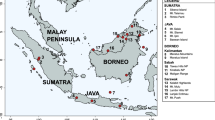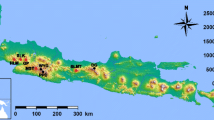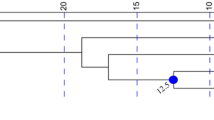Abstract
The taxonomy of rockhopper penguins, Eudyptes chrysocome (Forster 1781), is contentious. Some authorities recognise three subspecies based on morphological differences and geographical separation of breeding populations while others suggest that morphological differences support classifying rockhopper penguins as two distinct species. The taxonomy of rockhopper penguins is of more than academic interest as breeding colonies worldwide have declined markedly in size since the 1930s and rockhopper penguins are currently listed as vulnerable by the IUCN. We compared the genetic distances between three mitochondrial gene regions from the three putative rockhopper penguin subspecies with the distances between various penguin sister species to clarify the taxonomy and systematics of rockhopper penguins. Genetic distances between the rockhopper penguin taxa, relative to other closely related penguin species, support reclassifying the three rockhopper penguin subspecies as species. Reclassification of rockhopper penguins as three species could result in their conservation status being upgraded from vulnerable to endangered.





Similar content being viewed by others
References
Agapow P, Bininda-Emonds ORP, Crandall KA, Gittleman JL, Mace GM, Marshall JC, Purvis A (2004) The impact of species concept on biodiversity studies. Q Rev Biol 79:162–179
Avise JC (1994) Molecular markers, natural history and evolution. Chapman & Hall, New York
Baker AJ, Pereira SL, Haddrath OP, Edge K (2006) Multiple gene evidence for expansion of extant penguins out of Antarctica due to global cooling. Proc R Soc B 273:11–17
Banks JC, Mitchell AD, Waas JR, Paterson AM (2002) An unexpected pattern of molecular divergence within the blue penguin (Eudyptula minor) complex. Notornis 49:29–38
Bingham M (2002) The decline of Falkland Islands penguins in the presence of a commercial fishing industry. Rev Chil Hist Nat 75:805–818
Birdlife International (2000) Threatened birds of the world. Lynx Edicions and BirdLife International, Barcelona
Cherel Y, Hobson KA, Bailleul F, Groscolas R (2005) Nutrition, physiology and stable isotopes: new information from fasting and molting penguins. Ecology 86:2881–2888
Cooper J, Brown CR, Gales RP, Hindell MA, Klages NTW, Moors PJ, Pemberton D, Ridoux V, Thompson KR, van Heezik YM (1990) Diets and dietary segregation of crested penguins (Eudyptes). In: Davis LS, Darby JT (eds) Penguin biology. Academic, San Diego, pp 131–156
Cracraft J (1983) Species concepts and speciation analysis. In: Johnstone RF (ed) Current ornithology. Plenum Press, New York, pp 159–187
Cracraft J (1997) Species concepts in systematics and conservation biology––an ornithological viewpoint. In: Claridge MF, Dawah HA, Wilson MR (eds) Species: the units of biodiversity. Chapman and Hall, London, pp 325–340
Cunningham DM, Moors PJ (1994) The decline of rockhopper penguins Eudyptes chrysocome at Campbell Island, Southern Ocean and the influence of rising sea temperatures. Emu 94:27–36
del Hoyo J, Elliot A, Sargatal J (1992) Handbook of the birds of the world. Lynx Edicions, Barcelona
Excoffier L, Laval G, Schneider S (2005) Arlequin ver. 3.0: an integrated software package for population genetics data analysis. Evol Bioinform Online 1:47–50
Excoffier L, Smousse PE, Quattro JM (1992) Analysis of molecular variance inferred from metric distances among DNA haplotypes: application to human mitochondrial DNA restriction data. Genetics 131:479–491
Fordyce RE, Jones CM (1990) Penguin history and new fossil material from New Zealand. In: Davis LS, Darby JT (eds) Penguin biology. Academic, San Diego, pp 419–446
Guinard E, Weimerskirch H, Jouventin P (1998) Population changes of the Northern Rockhopper Penguin on Amsterdam and Saint Paul Islands. Colonial Waterbirds 21:222–228
Hasegawa M, Kishino H, Yano T (1985) Dating of the human-ape splitting by the molecular clock of mitochondrial DNA. J Mol Evol 22:160–174
Hey J (2001) Genes, categories and species. Oxford University Press, New York
Huelsenbeck JP, Ronquist F (2001) MR BAYES: Bayesian inference of phylogeny. Bioinformatics 17:754–755
IUCN (2004) 2004 IUCN Red list of threatened species. A global species assessment. IUCN Gland
Jouventin P (1982) Visual and vocal signals in penguins, their evolution and adaptive characters. Paul Parey, Berlin
Knox GA (1990) Land ocean interactions in the coastal zone. In: Global change in New Zealand. Proceedings of the Royal Society of New Zealand Conference. The Royal Society of New Zealand, Wellington, pp 32–44
Koubbi P (1993) Influence of the frontal zones on ichthyoplankton and mesopelagic fish assemblages in the Crozet Basin (Indian sector of the Southern Ocean). Polar Biol 13:557–564
Maddison WP, Maddison DR (1992) MacClade analysis of phylogeny and character evolution. Sinauer Associates, Inc., Massachusetts
Marchant S, Higgins PJ (1990) Handbook of Australian, New Zealand and Antarctic birds. Oxford University Press, Oxford
Marshall AG (1981) The ecology of ectoparasitic insects. Academic, London
McNeely JA (2002) The role of taxonomy in conserving biodiversity. J Nat Conserv 10:145–153
Miskelly CM, Sagar PM, Tennyson AJD, Scofield RP (2001) Birds of the Snares Islands, New Zealand. Notornis 48:1–40
Nylander JAA (2004) MrModeltest v2. Program distributed by the author. Evolutionary Biology Centre, Uppsala University, Uppsala
Park YH, Gambéroni L, Charriaud E (1993) Frontal structure, water masses, and circulation in the Crozet Basin. J Geophys Res 98:12361–12385
Price RD, Hellenthal RA, Palma RL (2003) World checklist of chewing lice with host associations and keys to families and genera. In: Price RD, Hellenthal RA, Palma RL, Johnson KP, Clayton DH (eds) The chewing lice. World checklist and biological overview. Illinois Natural History Survey Special Publication 24, Champaign, pp 1–448
Pütz K, Clausen AP, Huin N, Croxall JP (2003) Re-evaluation of historical penguin population data in the Falkland Islands. Waterbirds 26:169–175
Rodríguez F, Oliver JF, Marín A, Medina JR (1990) The general stochastic model of nucleotide substitution. J Theor Biol 142:485–501
Ronquist F, Huelsenbeck JP (2003) MrBayes 3: Bayesian phylogenetic inference under mixed models. Bioinformatics 19:1572–1574
Shaw PW, Arkhipkin AI, Al-Khairulla H (2004) Genetic structuring of Patagonian toothfish populations in the Southwest Atlantic Ocean: the effect of the Antarctic Polar Front and deep-water troughs as barriers to genetic exchange. Mol Ecol 13:3293–3303
Swofford DL (2002) Paup* Phylogenetic analysis using parsimony (*and other methods). Sinauer and Associates, Massachusetts
Tavaré L (1986) Some probabilistic and statistical problems on the analysis of DNA sequences. Lect Math Life Sci 17:57–86
Williams TD (1995) The penguins Spheniscidae. Oxford University Press, Oxford
Yang Z, Goldman N, Friday A (1994) Comparison of models for nucleotide substitution used in maximum-likelihood phylogenetic estimation. Mol Biol Evol 11:316–324
Acknowledgments
This work was funded by a Herbert Holdsworth Ross Award from the Center for Biodiversity, Illinois Natural History Survey and the Department of Entomology, University of Illinois, Urbana-Champaign. Amy van Buren thanks Ian Strange and the New Island Trust for support. Comments from Adrian Paterson and three anonymous reviewers improved this paper.
Author information
Authors and Affiliations
Corresponding author
Rights and permissions
About this article
Cite this article
Banks, J., Van Buren, A., Cherel, Y. et al. Genetic evidence for three species of rockhopper penguins, Eudyptes chrysocome . Polar Biol 30, 61–67 (2006). https://doi.org/10.1007/s00300-006-0160-3
Received:
Revised:
Accepted:
Published:
Issue Date:
DOI: https://doi.org/10.1007/s00300-006-0160-3




